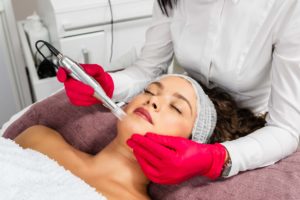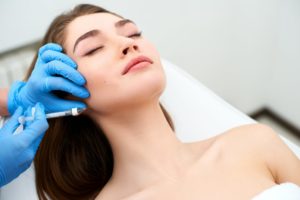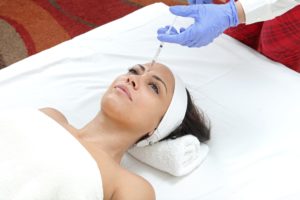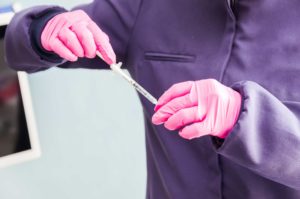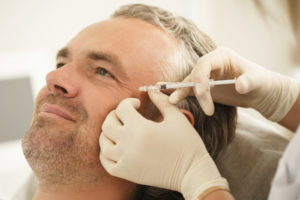
Aging skin is inevitable but with the help of information and technologies today, maintaining young-looking skin is now possible. Since collagen production slows down over time, the skin loses elasticity and becomes thinner and drier, making it more prone to wrinkles. With the help of a Neuromodulator, the skin relaxes and softens, restricting the facial muscles from contracting while diminishing wrinkles.
What Causes Wrinkles?
Many factors contribute to the onset of wrinkles, which include:
- Aging- With age, the skin cells divide slowly, causing the skin’s outer layer to thin and wrinkles to form.
- Facial muscle contractions- Facial muscles in the body have been used to smile, frown, or squint, which over time, cause frown lines between the eyebrows and crow’s feet at the corners of the eyes because of weakened fat or bone mass and the effects of gravity on the skin.
- Sun damage- Exposing the skin to the sun’s ultraviolet (UV) rays can cause the skin to age prematurely. In fact, the sun can damage collagen in your skin, which provides the elasticity and flexibility the skin needs to prevent wrinkles.
- Smoking- Tobacco products cause the body to slow down its production of collagen. Too little collagen causes wrinkles.
What Are 3 Important Tips To Reduce Wrinkles?
Protect The Skin From The Sun
It’s widely known that sun exposure can damage the skin, leading to premature aging and wrinkles. That said, regular sunscreen can slow down the skin’s aging signs. To protect the skin from UV (ultraviolet) rays, it’s essential to apply an SPF of between 30 and 50 daily, even if it’s cloudy.
This is because UV rays can still penetrate clouds, so sunscreen is really essential. Also, wear a wide-brim hat, light-colored clothes that’ll reflect the sun, and sunglasses with UV protection for extra protection.
Moisturize
Moisturizer is a huge help to nourish and hydrate the skin since it acts like a drink of water for the skin. In fact, this is important since the aging process makes the skin drier, making it more prone to wrinkles. According to research, using a moisturizer that contains hyaluronic acid and vitamin C is especially effective at preventing wrinkles from forming or getting deeper.
Skin Treatments
Neuromodulators have become one of the many cosmetic services most clinics and medspas utilize to give patients a smooth, youthful appearance. Neuromodulators are injections that relax wrinkles and face tension, organically creating more youthful skin. Though once considered a fad, more skin care experts and medical professionals see the benefits of neuromodulators not just for aesthetics but also for less facial tension – it improves wrinkles while helping to prevent them.
How Do Neuromodulators Work?
Neuromodulators work to interrupt the signal between a nerve and the muscle it attaches to, resulting in muscle relaxation. Because of that, the common signs of aging can be avoided, such as crow’s feet and wrinkles around the mouth. Indeed, neuromodulators relax facial muscles where wrinkles are visible, resulting in a more youthful complexion.
In addition, neuromodulators treat body areas like the face, neck, and chin. They are primarily used to treat:
- Aging skin
- Crow’s feet around eyes
- Excessive sweating
- Frown lines and forehead furrows
- Horizontal lines across the forehead
- Laugh lines around the mouth
- Marionette lines around the mouth
- Sagging skin
- Skin lines around the neck
- Smile lines
- Vertical lines between nose and mouth
- Worry lines or furrows
- Wrinkles
What Are The Types Of Neuromodulators?
Botox
Botox has been the most popular neuromodulator with the most extensive performance history and the largest market share. In fact, it’s also the only neuromodulator approved for all three major treatment areas: the forehead, between the brows, and crow’s-feet. Botox, also known as onabotulinumtoxinA, was officially cleared for cosmetic use in 2002 to smooth vertical lines between the eyebrows (known as glabellar lines).
Dysport
Dysport has become popular due to its spreadability, making it ideal for larger areas like the forehead. Also, it sets in slightly faster than its competitors, and anecdotal evidence suggests it may last longer, which makes it a popular choice among seasoned neurotoxin users. It is also known as abobotulinumtoxinA and was FDA-approved in 2009 to temporarily improve the appearance of moderate-to-severe glabellar lines and treat cervical dystonia in adults.
Jeuveau
Jeuveau is one of the only two neuromodulators approved for aesthetics-only usage, and it has only been on the market since 2019, meaning research and performance history is relatively limited. In fact, Jeuveau, also known as PrabotulinumtoxinA, is the second most recent neurotoxin injectable on the market and was approved to treat moderate to severe lines between the eyebrows.
Xeomin
Xeomin, or incobotulinumtoxinA, is also called the naked neurotoxin with a formula that uniquely doesn’t contain the same kinds of proteins as the others. Some considered this more “natural” due to its lack of stabilizing proteins, and it was approved for cosmetic use to treat frown lines between brows in 2011.
Who Is A Good Candidate For Neuromodulators?
Neuromodulators can be great for those who want an improved skin look but are not yet ready for (or do not wish to have) a surgical cosmetic procedure. Neuromodulators are often used with other techniques like laser resurfacing, medical-grade facials, or dermal fillers to complement and enhance those results.
How to Prepare For The Neuromodulators?
Before the procedure, doctors or healthcare providers will review the patient’s medical history. This time is perfect for the doctor and patient to discuss expectations, potential risks, and outcomes of the procedure for neuromodulators. Patients should tell their doctor if they use, have recently taken, or have had:
- Allergy or cold medicine
- Antibiotics by injection
- Blood-thinning drugs
- Drooping eyelid
- Headache
- Mild bruising
- Muscle relaxants
- Over-the-counter medication and supplements
- Previous neuromodulator therapy
- Sleep medicine
- Soreness
- Temporary weakness of surrounding muscle
What Are The Things To Do After The Procedure?
After the treatment, the patient may notice a small amount of redness and swelling in the injected area. This is only normal and will only last a few minutes. As a matter of fact, most patients do not feel any side effects or pain during and after their treatment, but some may experience mild headaches afterward.
Fortunately, an over-the-counter pain reliever can treat this. Most importantly, it is advised not to rub the injected area for at least 12 hours because this might cause the injected solution to move outside the targeted area. Since some neuromodulators would only last up to four months, follow-up sessions may be required to achieve the desired look.
The Bottom Line
Neuromodulators interrupt the signal between a nerve and the muscle it attaches to, which results in muscle relaxation. Beauty & Medicine Medspa offers Neuromodulators (Botox & Dysport) to treat and prevent these signs of aging by making strategic injections into the areas of concern to reduce muscle activity that causes wrinkles to form. With a highly trained staff, your safety is their number one priority while enhancing natural beauty.
.

